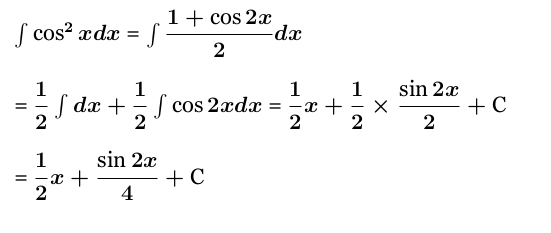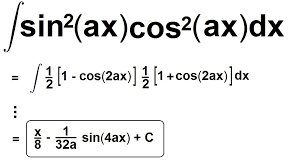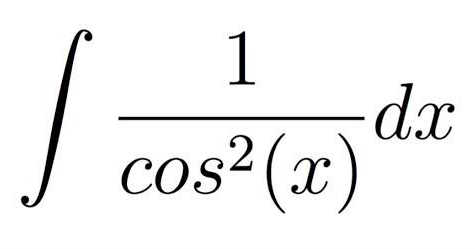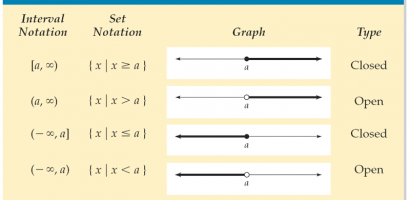This is the inverse process of determining a derivative. Integrations are the inverse of derivatives. Integrations are a method of combining parts to find the whole. The whole cake is integrated, and the slices are the differentiable functions that can be integrated. If f(x) is any function and f′(x) is one of its derivatives. f′(x) dx = f(x) + C is the integration of f′(x) with respect to dx.
Read Also: Difference Quotient Calculator: steps, formula, example and more
Integrals are classified into two types. Integrals that are indefinite: When there is no limit for integration, it is an integral of a function. It includes an arbitrary constant. Definite Integrals: A function integral with integration limits. The interval of integration has two values as its limits. The lower limit is the lower limit, and the upper limit is the upper limit. We do not include the arbitrary constant here.
Integral of cos^2x dx
Let us remember the double angle formula: cos(2x) = cos^2(x) – sin^2(x) .
We also know the trigonometric identity sin^2(x) + cos^2(x) = 1.
We also know the trigonometric identity sin^2(x) + cos^2(x) = 1.
This can now be rearranged as cos(2x) = 2cos^2(x) -1.
This can now be rearranged as cos(2x) = 2cos^2(x) -1.
So we have a better looking form of cos^2(x) that we can easily integrate using the reverse chain rule.
This provides us with an answer of x/2 + sin(2x)/4 +c.
However, let us see it in steps.
∫ cos^2x dx = ∫ (1 + cos2x)/2 dx
By simplifying, we get, 1/2 ∫ dx + 1/2 ∫ cos2x dx
= 1/2 . x + 1/2 . sin2x/2 +c
= x/2 + sin2x/4 + c (where c is an arbitrary constant)

Integral of cos^2x from 0 to 2pi
Let us use the power reduction formula.
cos^2x = (1 + cos2x)/2
So, we have I = ∫ 0 to 2pi (1 + cos2x)/2 dx
I = 1/2 ∫ 0 to 2pi (1+ cos2x ) dx
I = 1/2 ∫ 0 to 2pi dx + 1/2 ∫ 0 to 2pi cos2x dx
Hence, now, substitute u = 2x and taking integral on both sides, we get, 1/2 du = dx.
Also, the integral of cos u is sin u and reverse the substitution to get sin 2x.
So, now,
I = 1/2 [x] 0 to 2pi + 1/2 * 1/2 [sin 2x] 0 to 2pi.
Thus, the integral equals
I = 1/2 (2 pi) + 1/4 ( sin 4 pi – sin 0 )
I = pi – 1/4 ( 0 – 0)
So, I = pi
Integral of cos^2x from 0 to pi / 2
Let us first find out the integral of cos^2x. Hence, it is given as follows.
∫ cos^2x dx = ∫ (1 + cos2x)/2 dx
By further simplification, we get, 1/2 ∫ dx + 1/2 ∫ cos2x dx
= 1/2 . x + 1/2 . sin2x/2 +c
= x/2 + sin2x/4 + c (where c is an arbitrary constant)
Let us denote the above expression by F(x).
So, the integral of cos^2x from 0 to pi / 2 will be
∫ 0 to pi/2 cos^2x dx = F(pi/2) – F(0)
So, ∫ 0 to pi/2 cos^2x dx = 1/4 sin ( 2 * pi/2) + (pi/2)/2 – 1/4 sin ( 2 * 0/2 ) – 0/2
∫ 0 to pi/2 cos^2x dx = 1/4 sin pi + pi/4 – 1/4 sin 0 – 0
Again, ∫ 0 to pi/2 cos^2x dx = 1/4 * 0 + pi/4 – 1/4 * 0 – 0
Finally, ∫ 0 to pi/2 cos^2x dx = pi/4
Integral of cos^2x from 0 to pi/4
∫ 0 to pi/4 cos^2x dx can be written as ∫ 0 to pi/2 ( 1+ cos2x ) dx
Which is equal to 1/2 [x + sin2x /2 ] 0 to pi/2
Again, it is equal to 1/2 [pi/4 + (sin pi/2)/2 – 0 – sin0/0]
So, we get, ∫ 0 to pi/4 cos^2x dx = pi/8 + 1/4
Integral of cos^2x sin^2x
We know that sin 2x is equal to 2 sinx cosx
∫ cos^2x sin^2x dx = 1/4 ∫ (4 sin^2x cos^2x ) dx
So, this is equal to 1/4 ∫ sin^2(2x) dx
= 1/4 ( 1 – cos 4x )/2 dx
Hence, it is equal to x/8 – 1/8 ∫ cos 4x dx
Again, = x/8 – 1/8 * (sin 4x) / 4 + c
Thus, ∫ cos^2x sin^2x dx = x/8 – ( sin4x ) / 32 + c (where c is an arbitrary constant)

Integral of cos^2x sinx
∫ ( cos^2x sinx ) can be written as ∫ ( cos x )^2 * sinx dx
Let, u = cos x.
So, du = – sinx dx
Thus, ∫ ( cos x )^2 * sinx dx = – ∫ u^2 du
Therefore, this is equal to – u^3 / 3 + c.
Thus, the answer is – cos^3x / 3 + c (where c is an arbitrary constant)
Integral of cos^2x sin^3x
∫ cos^2x sin^3x = ∫ sinx ( sin^2x ) ( cos^2x ) DX
Thus, this is equal to ∫ sinx * cos^2x dx – ∫ sinx * cos^4x ex
So, now, let us put cos x = u
Thus, – sinx dx = du
Moreover, this implies – ∫ t^2 dt + ∫ t^4 dt
So, it is equal to – t^3 / 3 + t^5 / 5 + c
Thus, ∫ cos^2x sin^3x = cos^5x / 5 – cos^3x / 3 + c (where c is an arbitrary constant)
Integral of cos^2x sin^4x
∫ cos^2x sin^4x dx = ∫ ( sin^2x ) * ( sin^2x * cos^2x ) DX
Which is equal to ∫ 1/2 * ( 1 – cos2x ) * ( sin2x / 2 )^2 dx
We have cos2x = 1 – 2 sin^2x
sin^2x = 1/2 * ( 1 – cos2x )
And also, sin2x = 2sinx cosx
Further, the integral becomes
1/16 ( ∫ (1-cos4x)dx – ∫ sin^2(2x) d(sin2x))
Which is equal to 1/16 ( x – sin4x / 4 – sin^3(2x) / 3) + c (where c is an arbitrary constant)
Integral of 1 / cos^2x
Now, to find out this very interesting integral, please follow these steps.
Substitute 1/cos^x as 1/(cosx)^2
Then, ∫ 1/(cosx)^2 dx is equal to ∫ sec^2x dx
Thus, this now becomes very simple. I
Therefore, ∫ 1/(cosx)^2 = tan x + c (where c is an arbitrary constant)

Integral of cos^2x/cos^2x + 4sin^2x
Let, I = ∫ 0 to pi/2 cos^2x dx / cos^2x + 4sin^2x
Which is equal to ∫ 0 to pi/2 cos^2x dx / cos^2x + 4(1-cos^2x)
This, again becomes ∫ 0 to pi/2 cos^2x dx / 4 – 3cos^2x
This is equal to -1/3 ∫ 0 to pi/2 -3cos^2x dx / 4-3cos^2x dx
= – 1/3 ∫ 0 to pi/2 – 3cos^2x + 4 – 4 dx / 4-3 cos^2x
Thus, this is equal to – 1/3 ∫ 0 to pi/2 4 – 3cos^2x – 4 dx / 4-3cos^2x
Thus, we get, – 1/3 ∫ 0 to pi/2 1 – 4/ 4-3cos^2x dx
Now dividing the numerator and denominator by cos^2x, we get,
I = pi / 6
Integral of cos^2x/1+a^x
Let, I = ∫ pi to – pi cos^2x dx / 1+ a^x —- (1)
This is equal to ∫ pi to – pi cos^2(-x) dx / 1 + a^x
Which implies, ∫ pi to – pi cos^2x dx / 1 + a^x —- (2)
So, now, adding the two equations, we get,
2I = ∫ pi to – pi ( 1/ 1 + a^x + a^x / 1 + a^x) dx
Thus, I = ∫ 0 to pi cos^2x dx
Which is equal to 2 ∫ 0 to pi/2 cos^2x dx
Thus, ∫ pi to – pi cos^2x dx / 1+ a^x = pi/2
Integral of cos^2x/1+sinx
∫ cos^2x dx / 1 + sinx = ∫ 1-sin^2x dx / 1+sin^2x
Now, ∫ (1-sinx) * (1+sinx) dx / (1+sinx)
So, this implies, ∫ (1-sinx) dx
Which is equal to ∫ dx – ∫ sinx dx
Thus, this simplifies to x – (-cosx) + c
So, ∫ cos^2x dx / 1 + sinx = x + cosx + c (where c is an arbitrary constant)
Integral of cos3x cos2x dx
Let, I = ∫ cos3x cos2x dx
So, this is equal to 1/2 ∫ ( cos5x + cosx ) dx
Again, this simplifies to 1/2 [ sin5x / 5 + sinx ] + c
Hence, the solution to ∫ cos3x cos2x dx is 1/2 [ sin5x / 5 + sin x ] + c (where c is an arbitrary constant)
Integral of cos^2x by parts
So, now, we will look at the integration of cos^2x. We will do this by using the ‘by parts’ method.
The general form of this method is ∫ ( u * v ) = u ∫ v dx – ∫ ( du/dx ∫ v dx ) dx
Let us assume
I = ∫ cos^2x dx
So, I = ∫ cos x * cos x dx
Again, let us assume u = cos x and v = cos x
Hence,
I = cos x * sin x – ∫ [ ( – sin x ) * sin x ] dx
Thus, I = cos x * sin x + ∫ ( sin^2x ) dx
I = cos x * sin x + ∫ ( 1 – cos^2x ) dx
So, I = cos x * sin x + ∫ 1 dx – ∫ cos^2x dx
Again, we have seen that I = ∫ cos^2x dx
So, 2I = cos x * sin x + x + c
Therefore, I = 1/2 ( cos x * sin x ) + x/2 + c
Integral of cos^2x FAQs
1. What exactly is Cos integration?
The integral of cos(x) is sin(x) + C, where C is a constant, based on the fundamental theorem of calculus and the fact that the derivative of sin(x) is cos(x).
2. What is the cos 2x derivative?
-2sin(2x) is the derivative of cos(2x). In this, we use the chain rule process of finding this derivative. When calculating derivatives, we can use integrals to double-check our work. If D(x) is the derivative of f(x), then D(x) + C, where C is a constant, is the integral of D(x).
3. What exactly is Sinh?
Sinh is the hyperbolic sine function, which is the hyperbolic equivalent of the Sin circular function used in trigonometry. For real numbers, it is defined by allowing to be twice the area between the axis and a ray through the origin intersecting the unit hyperbola.
4. What exactly is CSC?
The cosecant (CSC) function is a trigonometry function.
The cosecant of an angle in a right triangle is the length of the hypotenuse divided by the length of the opposite side.
5. What is the cos2x formula?
To calculate cos 2x, we use the formula cos (A +B) = cos A cos B – sin A sin B. The cos(2x) formulas are as follows: 2(cosx)^2–1 = Cos (2x). Cos (2x) = 1–2(sinx)^2.
6. How does one go about locating a derivative?
You can find out the derivative of f(x) by using the very easy limit definition of derivatives. You can do this by going through these steps:
Determine f(x + h).
In the limit definition of a derivative, enter f(x + h), f(x), and h.
Reduce the difference quotient’s complexity.
Consider the simplified difference quotient’s limit as h approaches zero.
7. What exactly does sin 2x mean?
Sin x2 is an ordinary sine function because it is the “sine of (x-squared).” Sin2 x denotes “sine-squared of x,” which is not the same as the sine function.
8. What exactly is dy / dx?
There are a few simple rules that can be used to easily differentiate many functions. If y = some function of x (that is, if y equals an expression containing numbers and x’s), the derivative of y (with respect to x) is written dy/dx, which is pronounced “dee y by dee x.”
9. What is the sin pi value?
Simply place the point where you want it and press the button. The values of Cos pi and Sin pi are -1 and 0, respectively. Sin has a period of 2pi or 360° and its value repeats after 2pi or 360°. Sin has a range of 1 to -1 as well. sin0° = 0, sin90° = 1, sin180° = 0, sin270° = -1, and sin360° = 0.
10. How do I calculate the period of a function?
A periodic function’s period is the interval of x-values on which the graph’s cycle that is repeated in both directions lies. As a result, the period of the basic cosine function, f(x) = cos(x), is 2 pi.
11. Is antiderivative synonymous with an integral?
The answer I’ve always seen is: An integral typically has a defined limit, whereas an antiderivative is typically a general case with a +C, the constant of integration, at the end. Other than that, the only distinction between the two is that they are identical.
12. On the calculator, what is Sinh?
This function computes the hyperbolic sine of a value. The hyperbolic trig functions sinh(, cosh(, and tanh( are analogues of standard trig functions, but for a hyperbola rather than a circle. They can be expressed in real powers of e and are independent of the Degree or Radian mode settings.
13. Is tanh is the same as inverse tan?
As previously stated, tan and tanh are related to the function exp, whereas arc tan and arc tanh are related to the function log, implying that the transition from trigonometric to hyperbolic functions occurs in the complex domain. If that’s what you’re looking for, there’s the identity arcsin(tanhx)=arctan(sinhx).




